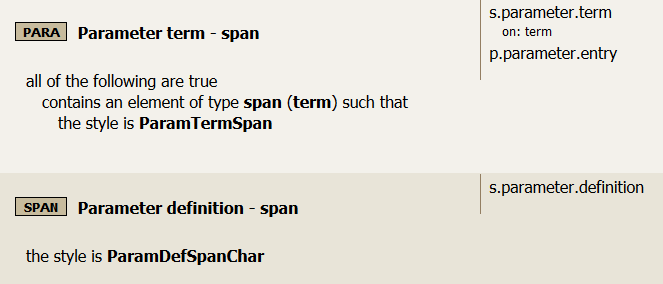Syntax #
s.parameter.term
s.parameter.definition
Purpose #
Parameter lists are sets of terms paired with their possible values. These parameters are inputs to an object of some kind. Sometimes these appear as tables in legacy documentation, while other times they appear as plain text.
Example:
Following are the parameters that apply to the annotation conref():
key – short label used to identify the text being referenced; any String
id-for-the-library (optional) – the file ID for your conref file; any String
filename (optional) – name for your file; this file will be included in your DITA output; any String
content (optional) – the text that will replace the conref in the published document; any String
topic-type (optional) – type of topic for your library file; String for topic type
In this example, the terms and values are in the same paragraph; you can apply the annotations s.parameter.term and s.parameter.definition to the appropriate spans. You will also need the annotation p.parameter.entry on the entire paragraph to make the set of terms and values into a single parameter list.
Here is what your rule may look like.
Your output may look like this.
<parml>
<plentry>
<pt>key</pt>
<pd>short label used to identify the text being referenced; any String</pd>
</plentry>
<plentry>
<pt>id-for-the-library (optional)</pt>
<pd>the file ID for your conref file; any String</pd>
</plentry>
<plentry>
<pt>filename (optional)</pt>
<pd>name for your file; this file will be included in your DITA output; any String</pd>
</plentry>
<plentry>
<pt>content (optional)</pt>
<pd>the text that will replace the conref in the published document; any String</pd>
</plentry>
<plentry>
<pt>topic-type (optional)</pt>
<pd>type of topic for your library file; String for topic type</pd>
</plentry>
</parml>




